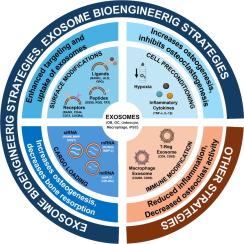骨质疏松症外泌体骨再生的治疗策略:挑战和潜在的解决方案
IF 13
1区 综合性期刊
Q1 MULTIDISCIPLINARY SCIENCES
引用次数: 0
摘要
背景骨质疏松症(OP)是一种进行性骨病,其特征是骨量减少和微结构恶化,从而增加骨折风险。目前的治疗方法只能部分恢复骨质量,而且长期使用往往会产生副作用。最近的研究强调外泌体是细胞外囊泡的一种亚型,是骨重塑的关键调节因子,具有良好的再生潜力。然而,它们在骨质疏松症中的作用仍未得到充分研究。本综述旨在探讨外泌体在骨再生中的作用如何为骨质疏松症的新治疗策略提供信息。通过将一般骨修复机制与骨质疏松病理联系起来,它评估了基于外泌体的干预的转化潜力和局限性。来自间充质干细胞、成骨细胞、破骨细胞和巨噬细胞的外泌体通过调节成骨、破骨细胞发生和免疫反应来调节骨稳态。在非骨质疏松的情况下,它们的再生作用是有证可循的。然而,外泌体异质性、清除速度快、靶向效率差等挑战阻碍了它们在骨质疏松症中的直接应用。最近的生物工程方法,包括成骨RNA或蛋白质装载和骨靶向表面修饰,显示出希望。此外,将外泌体与免疫调节或协同疗法结合可以进一步提高其疗效。尽管取得了这些进展,但在分离技术标准化、确保批次一致性和扩大临床使用生产方面仍然存在差距。这篇综述巩固了目前的知识,并概述了适应基于外泌体的骨再生策略的方向骨质疏松症治疗。本文章由计算机程序翻译,如有差异,请以英文原文为准。

Therapeutic strategy for exosome-based bone regeneration to osteoporosis: Challenges and potential solutions
Background
Osteoporosis (OP) is a progressive bone disease marked by reduced bone mass and microarchitectural deterioration, thereby increasing fracture risk. Current therapies only partly restore bone quality and often cause side effects with long-term use. Recent studies highlight exosomes, a subtype of extracellular vesicles, as key regulators of bone remodeling with promising regenerative potential. However, their role in osteoporosis remains underexplored.Aim of review
This review aims to investigate how the established role of exosomes in bone regeneration may inform novel therapeutic strategies for osteoporosis. By linking general bone repair mechanisms with osteoporotic pathology, it evaluates the translational potential and limitations of exosome-based interventions.Key scientific concepts of review
Exosomes derived from mesenchymal stem cells, osteoblasts, osteoclasts, and macrophages regulate bone homeostasis by modulating osteogenesis, osteoclastogenesis, and immune responses. Their regenerative effects in non-osteoporotic settings are well documented. However, challenges such as exosome heterogeneity, rapid clearance, and poor targeting efficiency impede their direct application in osteoporosis. Recent bioengineering approaches, including osteogenic RNA or protein loading and surface modifications for bone targeting, show promise. Moreover, combining exosomes with immunomodulatory or synergistic therapies may further enhance their efficacy. Despite these advances, gaps persist in standardizing isolation techniques, ensuring batch consistency, and scaling up production for clinical use. This review consolidates current knowledge and outlines directions for adapting exosome-based bone regenerative strategies to osteoporosis treatment.求助全文
通过发布文献求助,成功后即可免费获取论文全文。
去求助
来源期刊

Journal of Advanced Research
Multidisciplinary-Multidisciplinary
CiteScore
21.60
自引率
0.90%
发文量
280
审稿时长
12 weeks
期刊介绍:
Journal of Advanced Research (J. Adv. Res.) is an applied/natural sciences, peer-reviewed journal that focuses on interdisciplinary research. The journal aims to contribute to applied research and knowledge worldwide through the publication of original and high-quality research articles in the fields of Medicine, Pharmaceutical Sciences, Dentistry, Physical Therapy, Veterinary Medicine, and Basic and Biological Sciences.
The following abstracting and indexing services cover the Journal of Advanced Research: PubMed/Medline, Essential Science Indicators, Web of Science, Scopus, PubMed Central, PubMed, Science Citation Index Expanded, Directory of Open Access Journals (DOAJ), and INSPEC.
 求助内容:
求助内容: 应助结果提醒方式:
应助结果提醒方式:


